
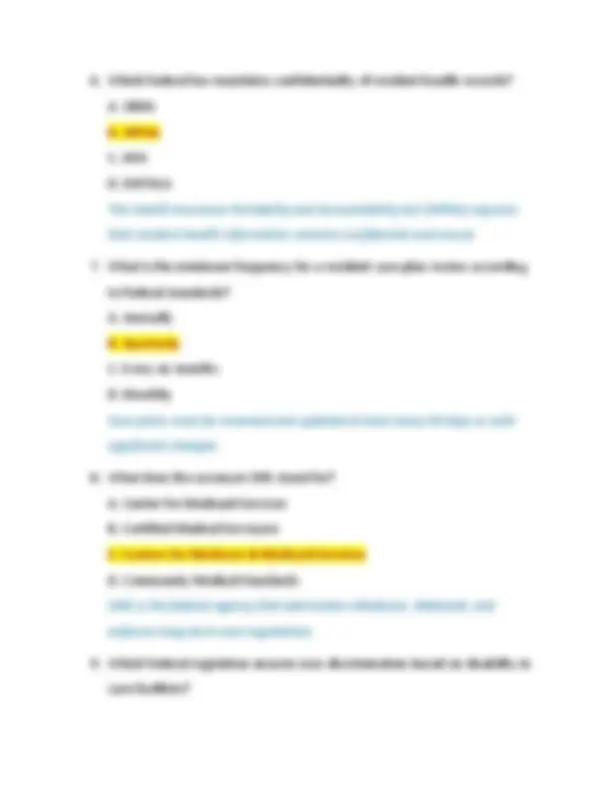

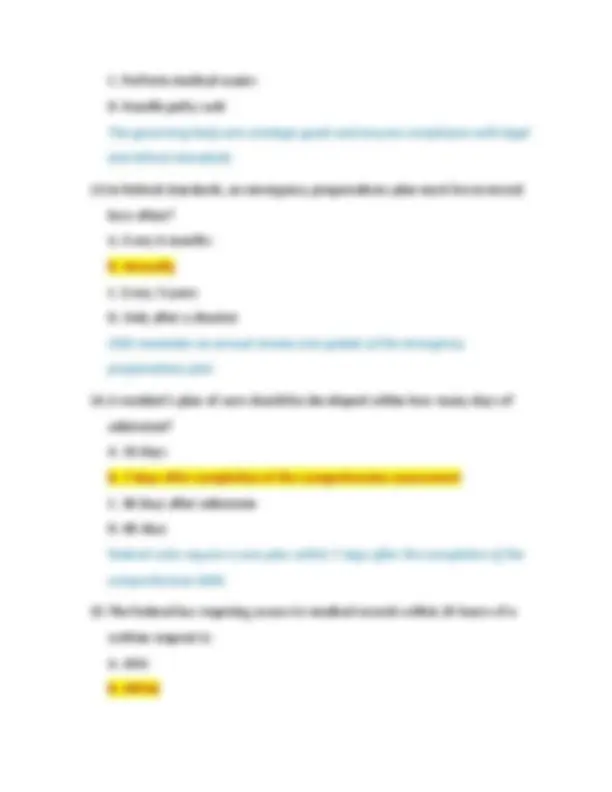
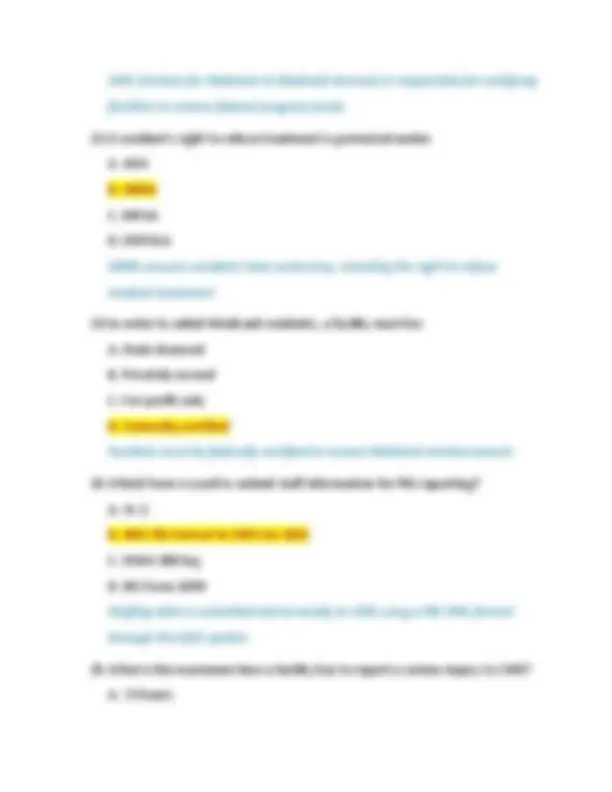
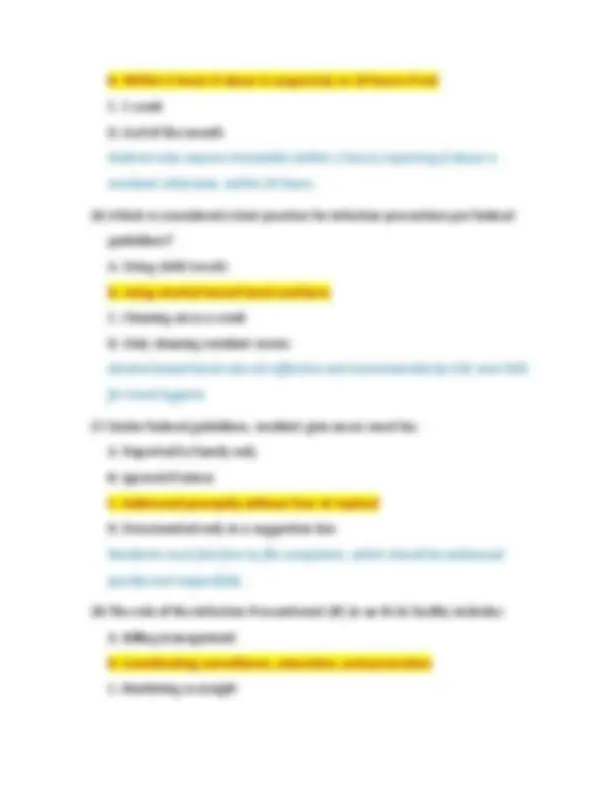
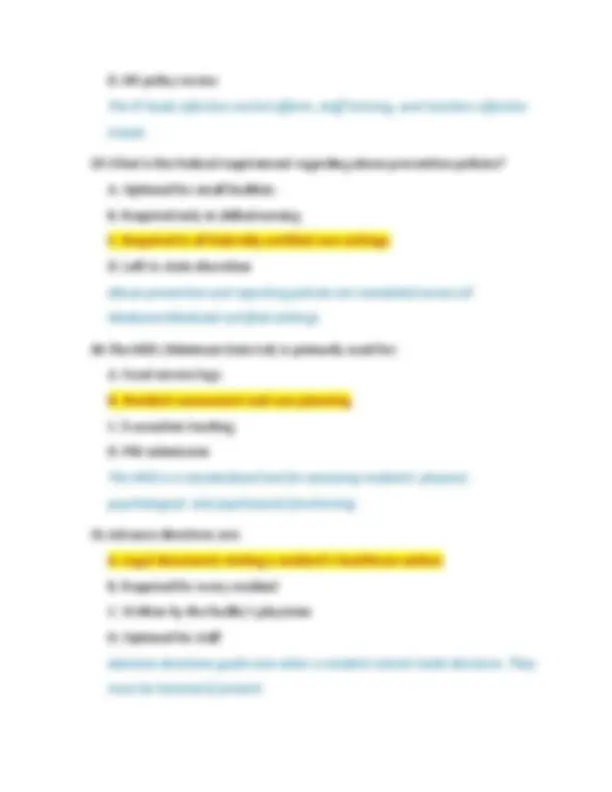

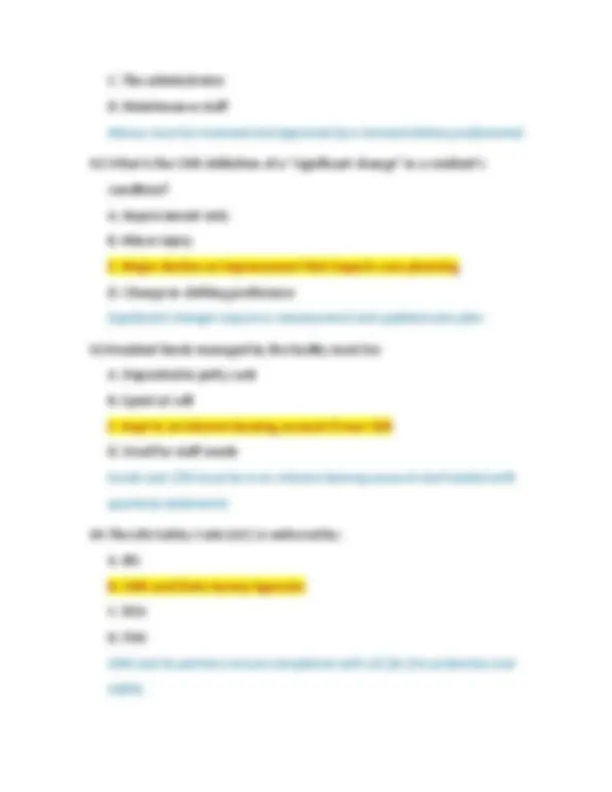
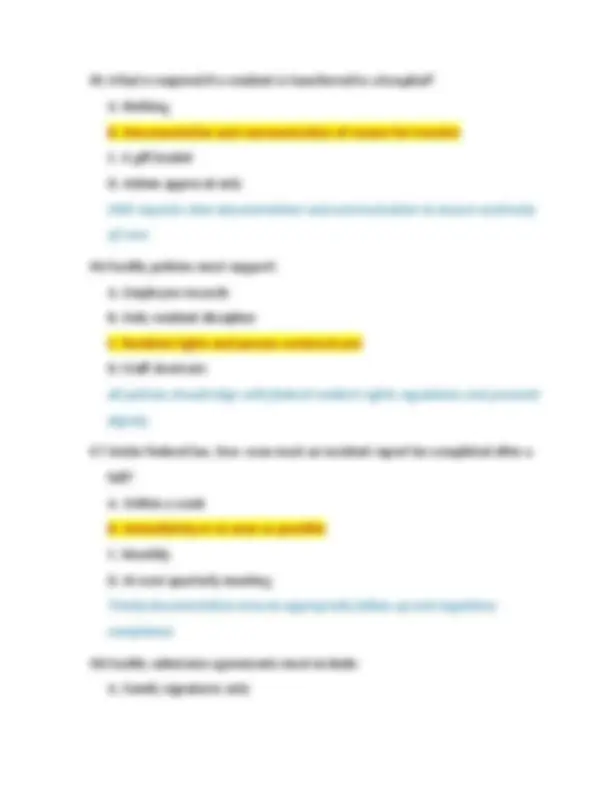
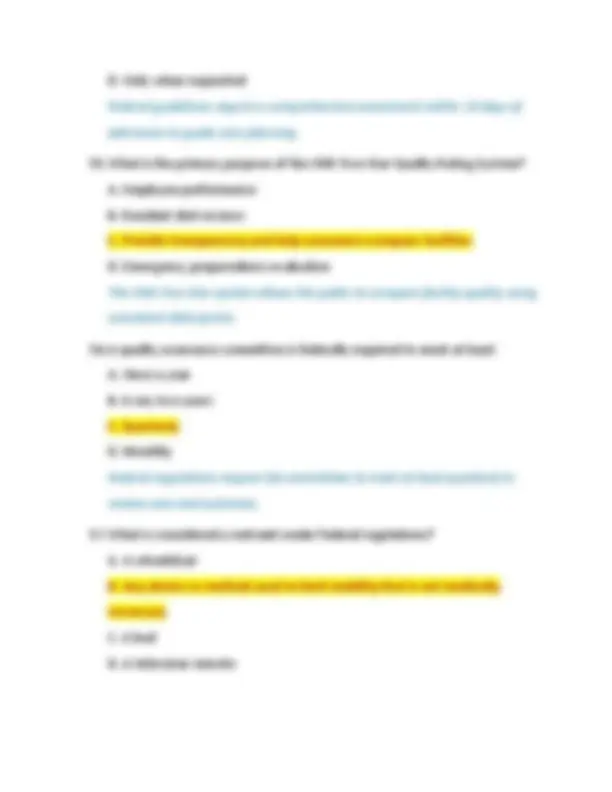
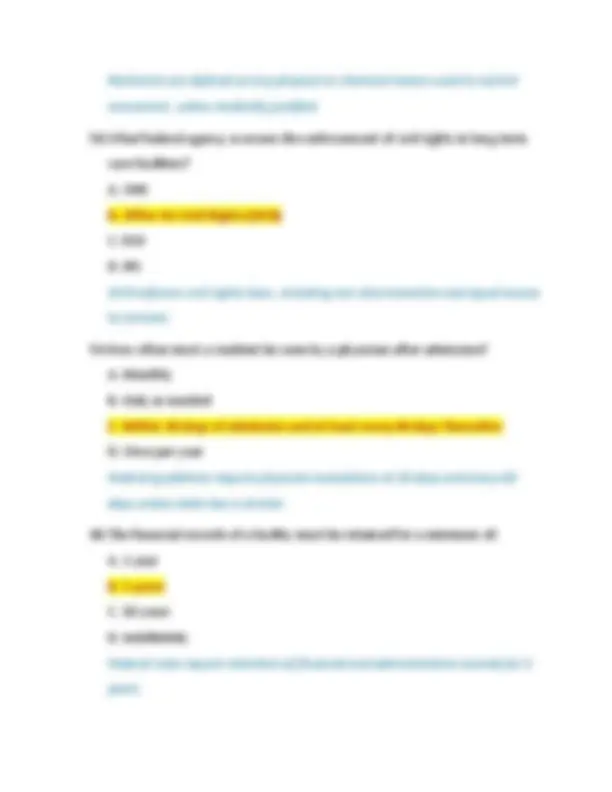
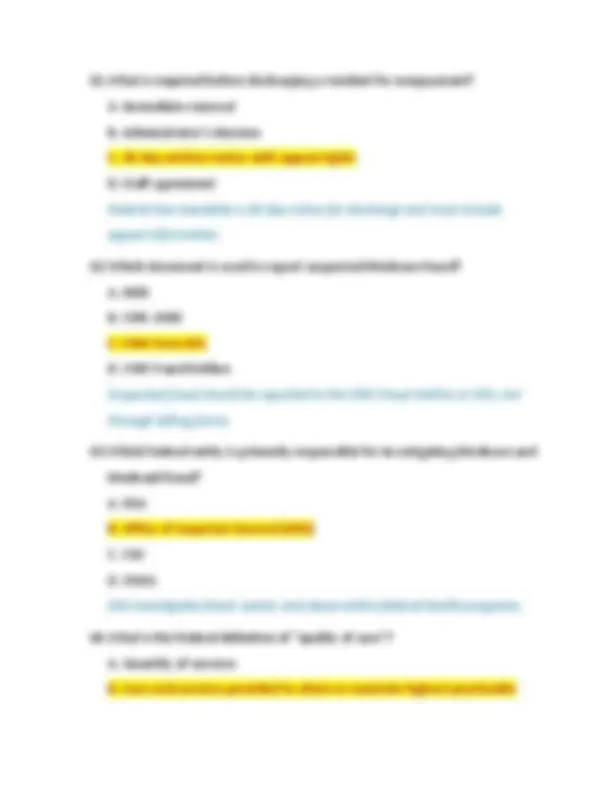
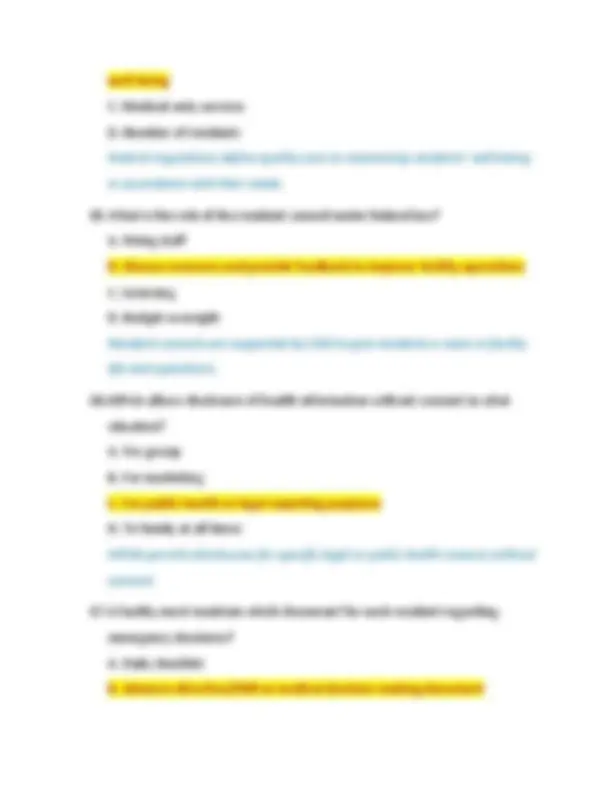
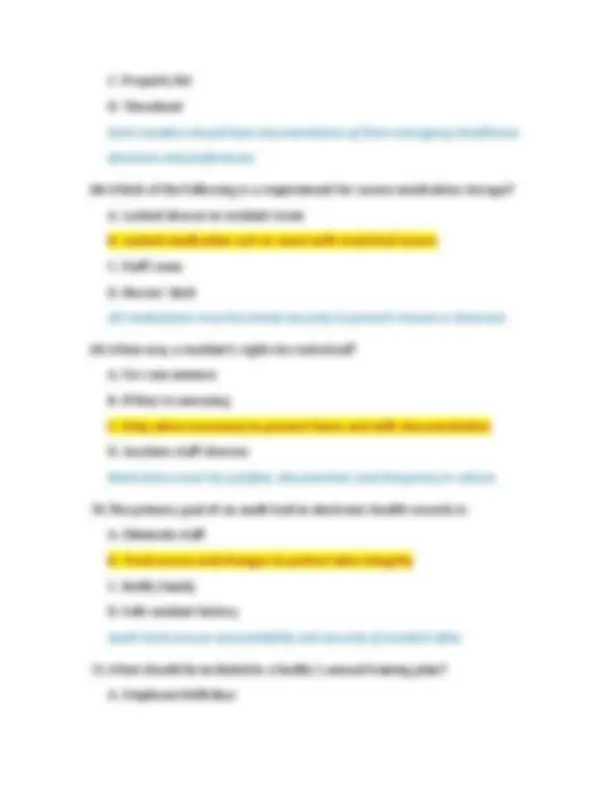
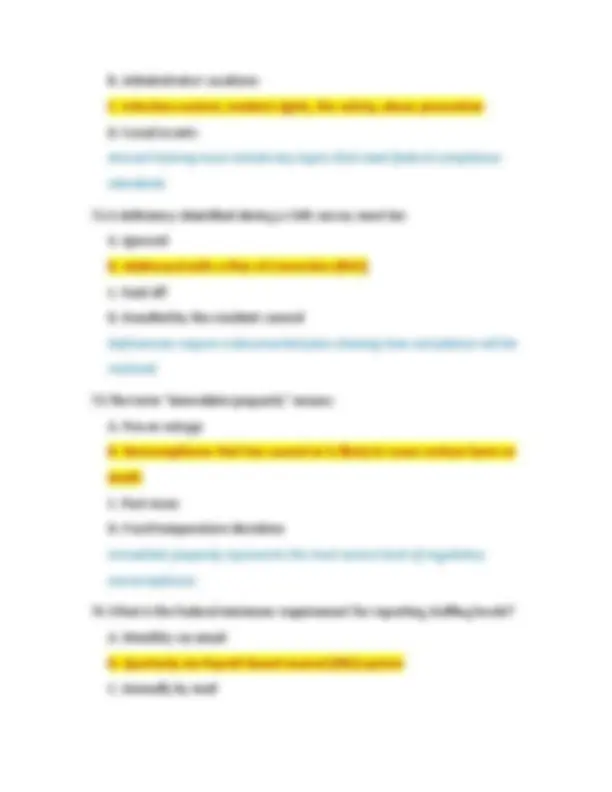
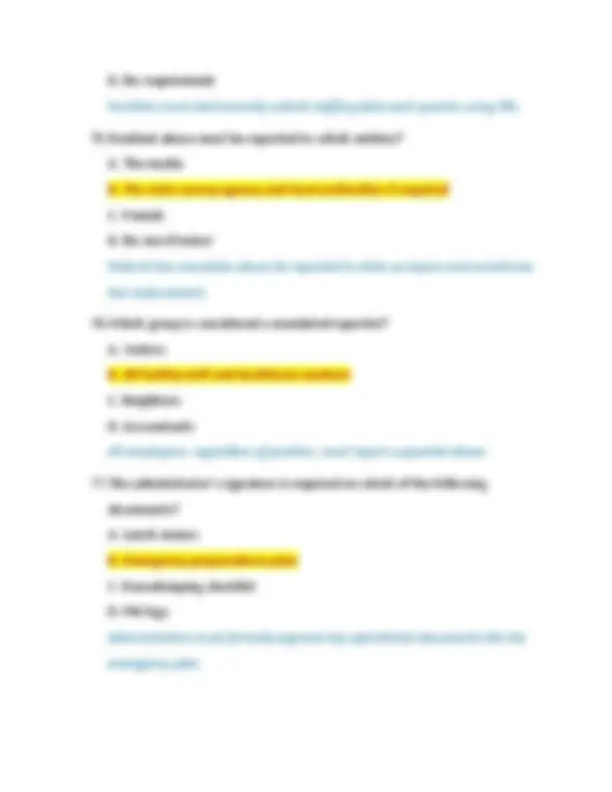
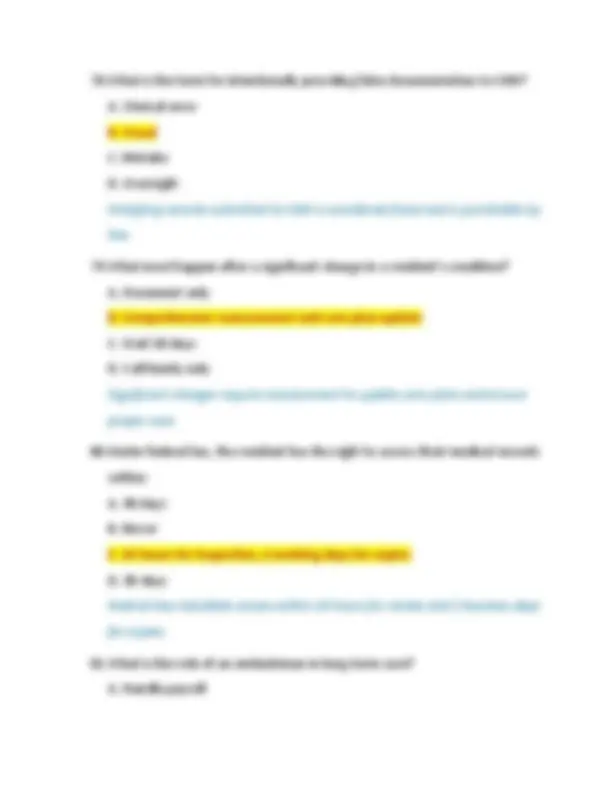
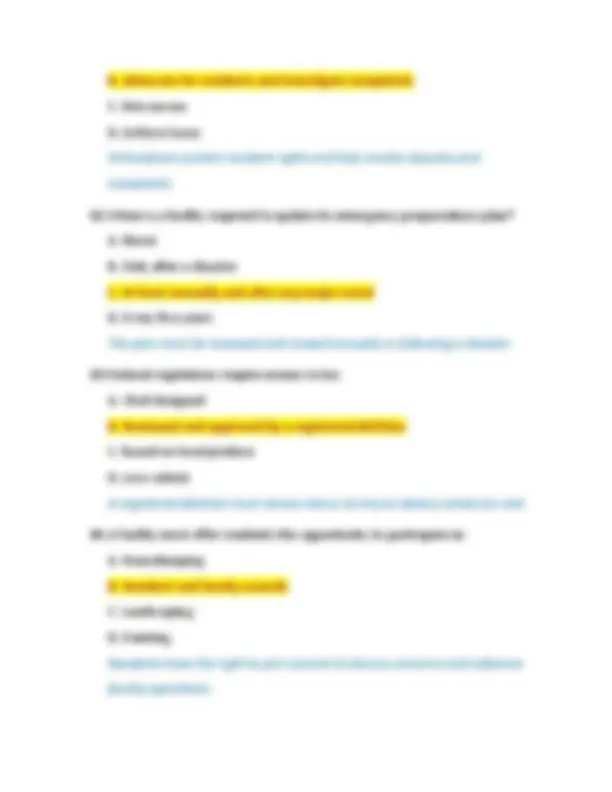
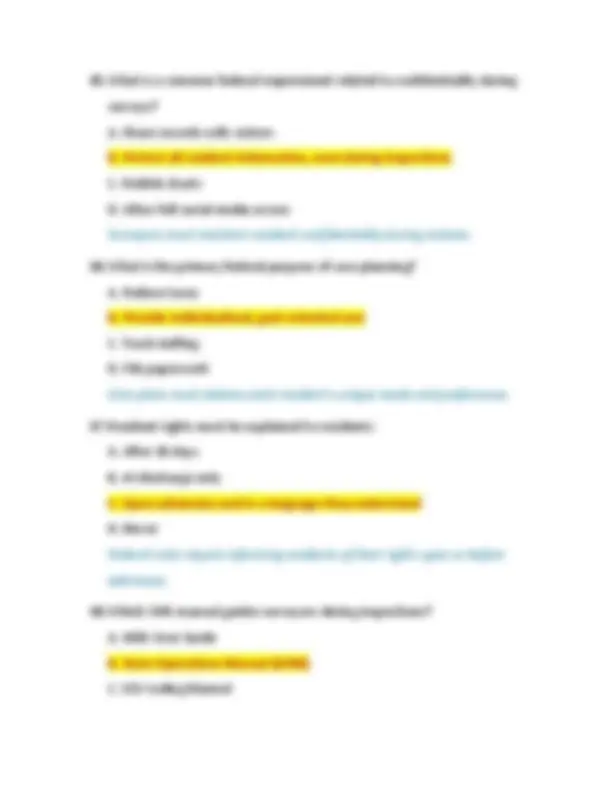
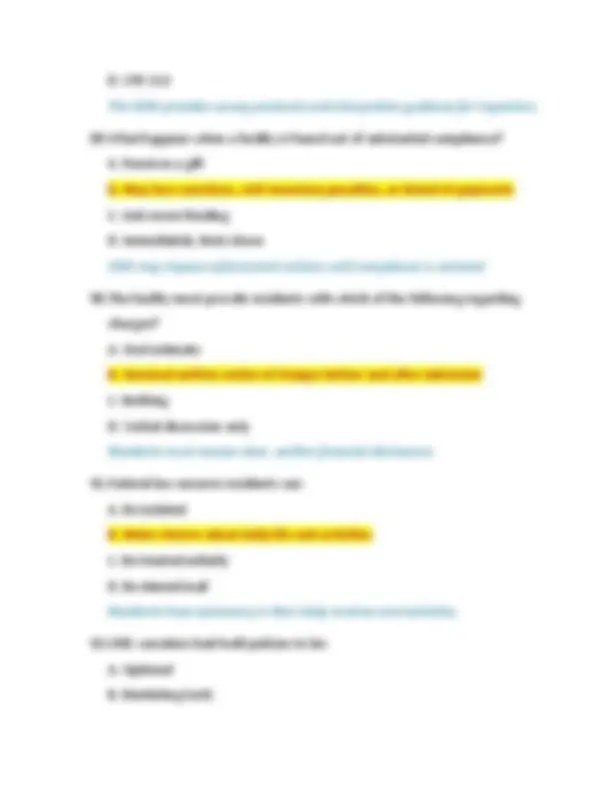
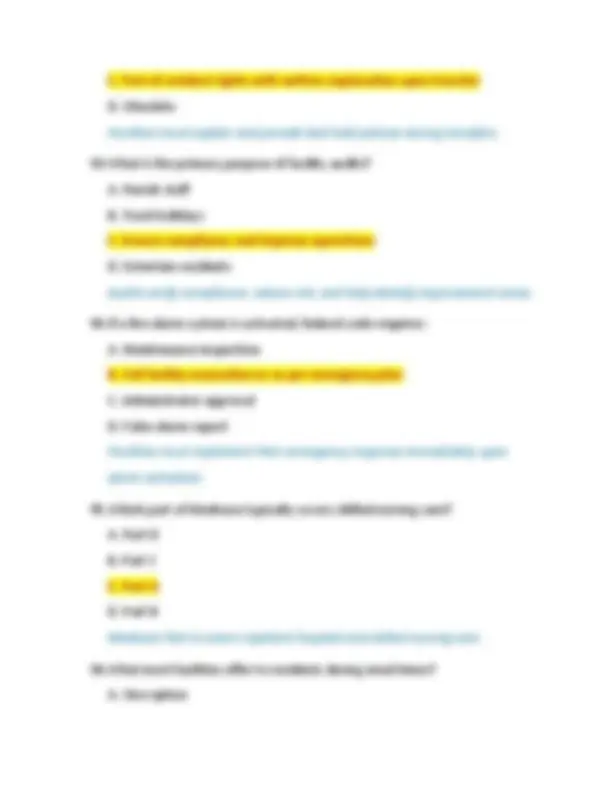
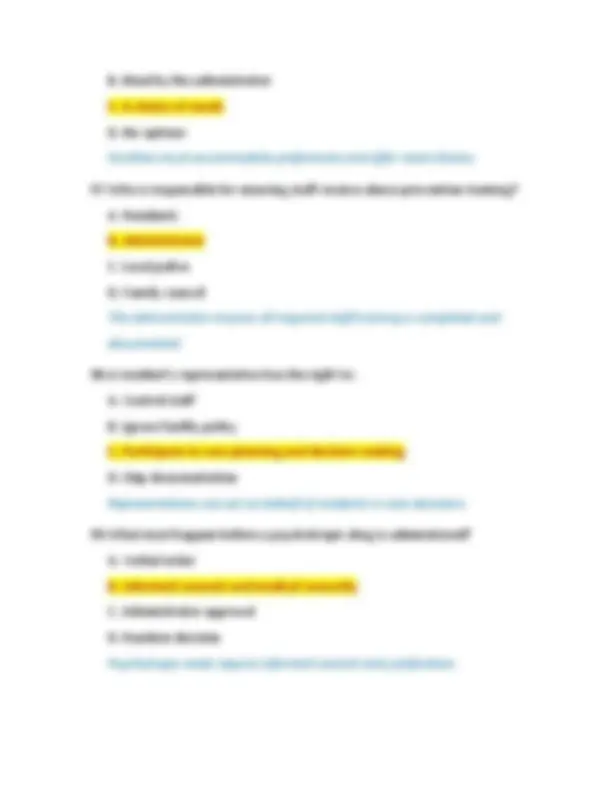
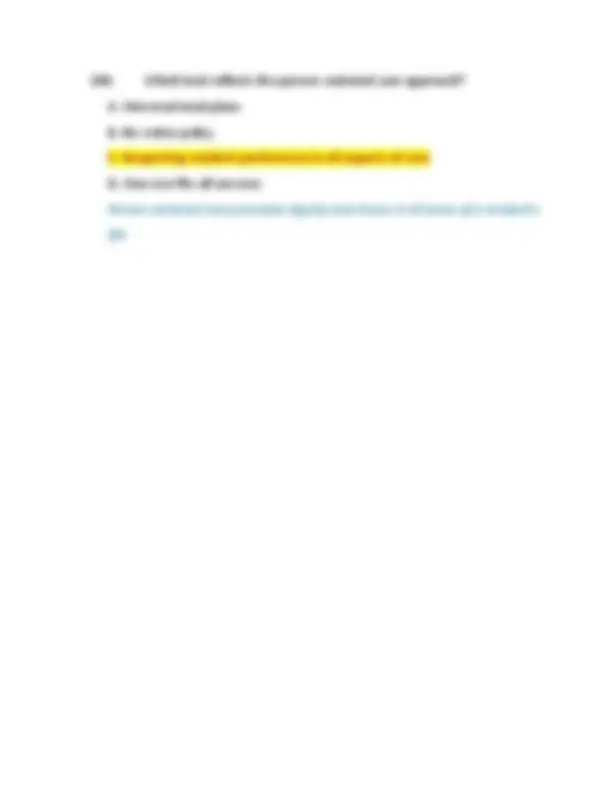


Study with the several resources on Docsity

Earn points by helping other students or get them with a premium plan


Prepare for your exams
Study with the several resources on Docsity

Earn points to download
Earn points by helping other students or get them with a premium plan
Community
Ask the community for help and clear up your study doubts
Discover the best universities in your country according to Docsity users
Free resources
Download our free guides on studying techniques, anxiety management strategies, and thesis advice from Docsity tutors
RCAL - NAB Administrator Exam (Federal Questions And Correct Answers (Verified Answers) Plus Rationales 2025 Q&A | Instant Download based on key federal content domains, including governance, human resources, finance, regulations, and resident care.
Typology: Exams
1 / 31

This page cannot be seen from the preview
Don't miss anything!
























A. Americans with Disabilities Act (ADA) B. HIPAA C. OBRA D. Title VII The ADA mandates accessibility and prohibits discrimination against individuals with disabilities. 10.What is the federally required minimum staffing documentation tool for assisted living facilities? A. OSHA Log B. Staff schedule and payroll-based journal (PBJ) C. Fire drill logs D. Shift report The PBJ system is used by CMS to monitor staffing levels and ensure adequate coverage. 11.What must be reported under federal elder abuse laws? A. Only physical abuse B. Any suspected abuse, neglect, or exploitation C. Financial abuse only D. Only abuse confirmed by law enforcement Mandated reporters must report any suspicion of abuse, neglect, or exploitation of residents. 12.What is the primary role of a governing body in a residential care facility? A. Establish policies and oversee overall operations B. Hire janitorial staff
C. Perform medical exams D. Handle petty cash The governing body sets strategic goals and ensures compliance with legal and ethical standards. 13.In federal standards, an emergency preparedness plan must be reviewed how often? A. Every 6 months B. Annually C. Every 3 years D. Only after a disaster CMS mandates an annual review and update of the emergency preparedness plan. 14.A resident's plan of care should be developed within how many days of admission? A. 10 days B. 7 days after completion of the comprehensive assessment C. 30 days after admission D. 60 days Federal rules require a care plan within 7 days after the completion of the comprehensive MDS. 15.The federal law requiring access to medical records within 24 hours of a written request is: A. ADA B. HIPAA
OBRA 1987 reformed nursing home care by emphasizing residents' rights and quality of care. 19.What must be included in a facility’s infection control program? A. Housekeeping checklists B. Activity calendars C. Surveillance, prevention, and reporting systems D. Evacuation routes An effective infection control program includes systems for detection, prevention, and reporting of infections. 20.The federal requirement for food service includes serving meals that are: A. High in sodium B. Based only on administrator preference C. Nutritious, palatable, and meet dietary needs D. Delivered weekly Facilities must ensure meals are nutritious, meet dietary requirements, and are appealing to residents. 21.Which federal agency certifies residential care communities for participation in Medicare and Medicaid? A. OSHA B. IRS C. CMS D. FDA
CMS (Centers for Medicare & Medicaid Services) is responsible for certifying facilities to receive federal program funds. 22.A resident's right to refuse treatment is protected under: A. ADA B. OBRA C. HIPAA D. EMTALA OBRA ensures residents have autonomy, including the right to refuse medical treatment. 23.In order to admit Medicaid residents, a facility must be: A. State-licensed B. Privately owned C. For-profit only D. Federally certified Facilities must be federally certified to receive Medicaid reimbursement. 24.Which form is used to submit staff information for PBJ reporting? A. W- 2 B. XML file format to CMS via QIES C. OSHA 300 log D. IRS Form 1099 Staffing data is submitted electronically to CMS using a PBJ XML format through the QIES system. 25.What is the maximum time a facility has to report a serious injury to CMS? A. 72 hours
D. HR policy review The IP leads infection control efforts, staff training, and monitors infection trends. 29.What is the federal requirement regarding abuse prevention policies? A. Optional for small facilities B. Required only in skilled nursing C. Required in all federally certified care settings D. Left to state discretion Abuse prevention and reporting policies are mandated across all Medicare/Medicaid-certified settings. 30.The MDS (Minimum Data Set) is primarily used for: A. Food service logs B. Resident assessment and care planning C. Evacuation tracking D. PBJ submission The MDS is a standardized tool for assessing residents’ physical, psychological, and psychosocial functioning. 31.Advance directives are: A. Legal documents stating a resident’s healthcare wishes B. Required for every resident C. Written by the facility’s physician D. Optional for staff Advance directives guide care when a resident cannot make decisions. They must be honored if present.
32.A facility’s emergency plan must include provisions for: A. Repainting the building B. Resident evacuation and communication with families C. Laundry procedures D. Landscaping maintenance Emergency plans must ensure safe resident evacuation and establish communication procedures. 33.Which of the following best describes the term "involuntary discharge"? A. Resident leaves by choice B. Facility discharges a resident without their consent under limited conditions C. Resident expires D. Resident is transferred for preference Involuntary discharge must meet federal criteria and be documented with notice. 34.How often must fire extinguishers be inspected according to federal life safety codes? A. Every 3 years B. Every 2 years C. Monthly visual inspection and annual maintenance check D. Only when used Facilities must conduct a quick monthly check and a formal annual inspection of fire extinguishers.
38.The required training for staff in dementia care should be: A. Optional B. Based on facility resources C. Ongoing and competency-based D. Annually without follow-up Federal best practices encourage continual training and assessment of dementia care competencies. 39.When must a resident be offered the influenza vaccine? A. Every 5 years B. Annually unless contraindicated C. Only at admission D. Never, unless requested Residents must be offered an annual flu vaccine as part of infection control and health promotion. 40.What is the role of the administrator during a survey? A. Leave the building B. Ensure access, transparency, and support to surveyors C. Coach staff to avoid questions D. Decline surveyor entry Administrators must cooperate fully, provide documents, and assist with regulatory surveys. 41.To meet federal dietary requirements, meals must be planned by: A. Activities coordinator B. A registered dietitian or dietary manager
C. The administrator D. Maintenance staff Menus must be reviewed and approved by a licensed dietary professional. 42.What is the CMS definition of a “significant change” in a resident’s condition? A. Improvement only B. Minor injury C. Major decline or improvement that impacts care planning D. Change in clothing preference Significant changes require a reassessment and updated care plan. 43.Resident funds managed by the facility must be: A. Deposited in petty cash B. Spent at will C. Kept in an interest-bearing account if over $ D. Used for staff needs Funds over $50 must be in an interest-bearing account and tracked with quarterly statements. 44.The Life Safety Code (LSC) is enforced by: A. IRS B. CMS and State Survey Agencies C. DEA D. FDA CMS and its partners ensure compliance with LSC for fire protection and safety.
B. Services provided, charges, and resident rights C. Just a phone number D. Marketing materials Clear terms help ensure informed consent and understanding of services and rights. 49.The federal requirement for staff influenza vaccination program is: A. Not required B. Optional for contractors C. Strongly recommended with documentation of education and declination if refused D. Mandated without exception Facilities must offer education and obtain documentation for vaccination or refusal. 50.A resident has the right to: A. Be restrained without consent B. Be denied visitors C. Choose their attending physician D. Be isolated for convenience Residents have the right to choose their healthcare providers under OBRA regulations. 51.Which federal regulation prohibits retaliation against staff who report abuse? A. HIPAA
C. Elder Justice Act D. FMLA The Elder Justice Act protects whistleblowers from retaliation when reporting elder abuse or neglect. 52.What is a requirement of a compliant grievance process under federal regulations? A. Must be written in legal language B. Must be easy to access and without retaliation C. Only available to family D. Requires attorney involvement Federal rules require that grievance procedures are clearly communicated, accessible, and safe from retaliation. 53.A facility’s disaster plan must include which element? A. Cost of repairs B. Continuity of operations (COOP) C. Tax preparation D. Weekly menus A disaster/emergency preparedness plan must ensure continuity of operations during and after a disaster. 54.When is an MDS (Minimum Data Set) comprehensive assessment required? A. At discharge B. Within 14 days of admission C. Only annually
Restraints are defined as any physical or chemical means used to restrict movement, unless medically justified. 58.What federal agency oversees the enforcement of civil rights in long-term care facilities? A. CMS B. Office for Civil Rights (OCR) C. DOJ D. IRS OCR enforces civil rights laws, including non-discrimination and equal access to services. 59.How often must a resident be seen by a physician after admission? A. Monthly B. Only as needed C. Within 30 days of admission and at least every 60 days thereafter D. Once per year Federal guidelines require physician evaluations at 30 days and every 60 days unless state law is stricter. 60.The financial records of a facility must be retained for a minimum of: A. 1 year B. 5 years C. 10 years D. Indefinitely Federal rules require retention of financial and administrative records for 5 years.
61.What is required before discharging a resident for nonpayment? A. Immediate removal B. Administrator's decision C. 30-day written notice with appeal rights D. Staff agreement Federal law mandates a 30-day notice for discharge and must include appeal information. 62.Which document is used to report suspected Medicare fraud? A. MDS B. CMS- 1500 C. CMS Form 855 D. CMS Fraud Hotline Suspected fraud should be reported to the CMS Fraud Hotline or OIG, not through billing forms. 63.Which federal entity is primarily responsible for investigating Medicare and Medicaid fraud? A. FDA B. Office of Inspector General (OIG) C. CDC D. OSHA OIG investigates fraud, waste, and abuse within federal health programs. 64.What is the federal definition of “quality of care”? A. Quantity of services B. Care and services provided to attain or maintain highest practicable